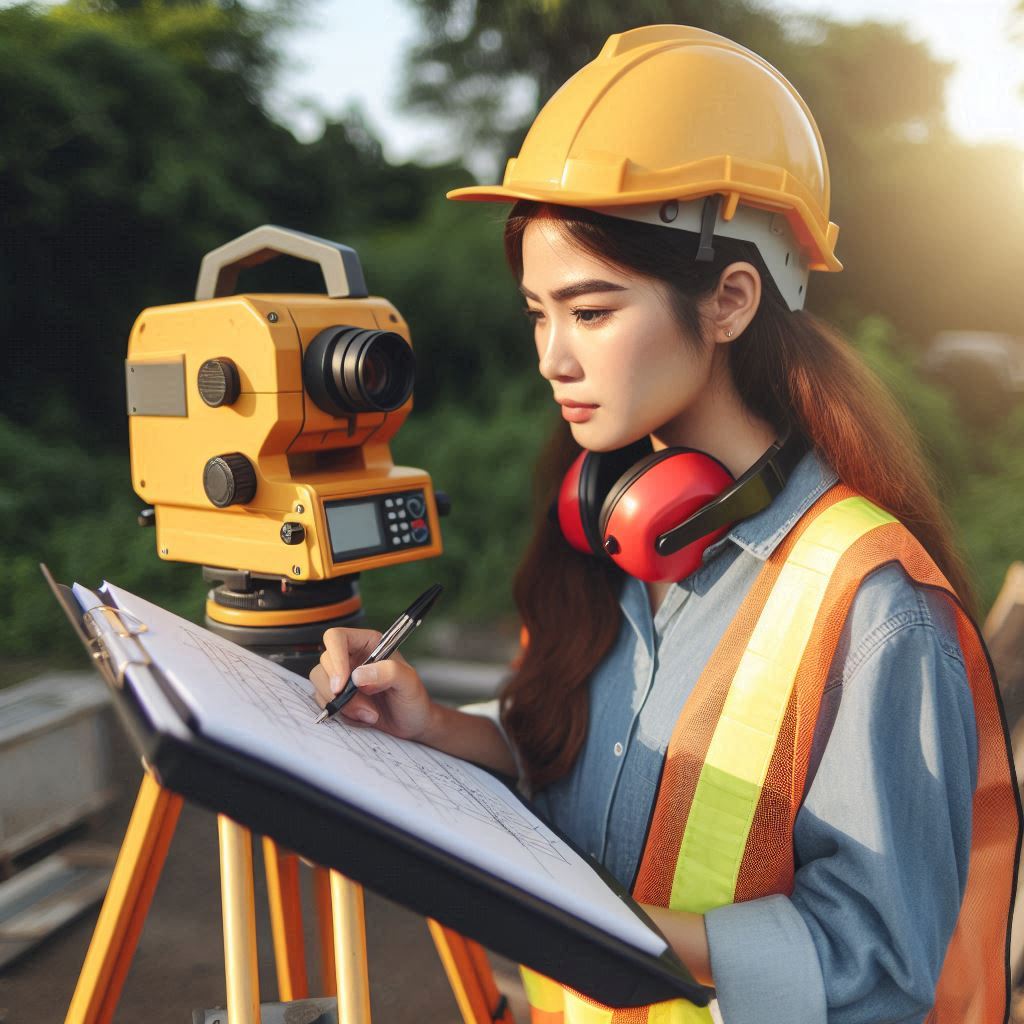Introduction
Surveying and mapping are fundamental processes in various industries, from construction to urban planning.
They involve precise measurement of land and the creation of detailed maps.
Accuracy in these processes is critical for ensuring that the data is reliable and useful.
Accurate surveying and mapping can significantly impact project success, safety, and legal compliance.
Define Surveying and Mapping
Surveying is the science of measuring and mapping the Earth’s surface.
It involves calculating distances, angles, and elevations to establish the precise location of points.
Surveyors use specialized equipment to gather this data, which forms the basis of various applications.
Mapping, on the other hand, is the process of creating visual representations of this data.
It transforms raw measurements into detailed maps that depict geographic features, boundaries, and infrastructure.
Importance of Accuracy in Surveying and Mapping
Accuracy in surveying and mapping is crucial for several reasons.
First, precise measurements ensure that construction projects are built according to design specifications.
Any inaccuracies can lead to structural issues, costly rework, or even safety hazards.
Second, accurate mapping supports effective land use planning and resource management.
It helps in making informed decisions about zoning, development, and environmental conservation.
Third, reliable data is essential for legal and property disputes.
Accurate surveys and maps provide clear evidence in legal matters involving land ownership and boundaries.
Preview of Key Points to Be Discussed
In this post, we will explore the significance of accuracy in surveying and mapping in more detail.
We will discuss how precision impacts project outcomes, including construction quality and safety.
We will also examine methods and technologies used to ensure high levels of accuracy.
Additionally, we will highlight real-world examples where accuracy made a difference.
By understanding these aspects, we will underscore why maintaining accuracy is fundamental in surveying and mapping.
Accuracy ensures reliable data
Importance of Precise Measurements in Surveying
Precise measurements are crucial in surveying for accurate data collection.
Surveying technicians use specialized tools to measure distances, angles, and elevations precisely.
Accurate measurements ensure the integrity of maps and property boundaries.
They prevent costly errors and disputes in real estate transactions and construction projects.
Small deviations in measurements can lead to significant discrepancies in the final results.
Precision in surveying supports reliable infrastructure development and land use planning.
Technicians must regularly calibrate their instruments to maintain measurement accuracy.
They should also adhere to established standards and procedures to ensure consistency.
Accurate data provides a solid foundation for various applications, including engineering, environmental studies, and urban planning.
Impact of Inaccurate Data on Decision-Making
Inaccurate data can severely impact decision-making processes.
When surveying data is flawed, it leads to incorrect assessments and planning errors.
Construction projects based on inaccurate measurements can face structural issues and safety hazards.
Poorly mapped land boundaries can result in legal disputes and financial losses.
Inaccurate data affects resource allocation and land development decisions, leading to inefficiencies.
Decision-makers rely on precise data to make informed choices and avoid costly mistakes.
Errors in data can compromise the reliability of scientific research and environmental assessments.
Ensuring data accuracy is essential for effective decision-making and project success.
Organizations must implement rigorous data validation techniques to prevent inaccuracies.
Examples of Real-Life Consequences of Inaccurate Mapping
Inaccurate mapping can lead to severe real-life consequences.
For example, flawed property surveys can cause boundary disputes between neighbors.
These disputes often result in legal battles and financial settlements.
Inaccurate data in construction projects can lead to structural failures, posing safety risks to occupants.
In one case, a miscalculated elevation led to flooding in a newly developed area, causing significant property damage.
Environmental mapping errors can result in mismanagement of natural resources and habitat destruction.
In urban planning, inaccurate maps can lead to inefficient land use and wasted resources.
Incorrect mapping of utilities can disrupt services and cause costly repairs.
These examples highlight the critical need for accuracy in surveying and mapping to prevent adverse outcomes.
Safety and infrastructure development
Role of Accurate Surveying in Preventing Accidents
Accurate surveying plays a crucial role in preventing accidents.
When surveyors provide precise measurements, they help identify potential hazards.
Accurate surveys ensure that construction sites are safe and compliant with regulations.
They help prevent structural failures and accidents by providing exact data for site preparation.
Surveying errors can lead to unsafe conditions, which may cause injuries or property damage.
By ensuring high accuracy, surveyors contribute to a safer environment for workers and the public.
Correct data also helps in positioning safety barriers and signs effectively.
Proper surveying minimizes the risk of accidents caused by misjudged distances or incorrect elevations.
Overall, precision in surveying significantly reduces the likelihood of accidents on construction sites and in public spaces.
Importance of Precise Mapping in Infrastructure Projects
Precise mapping is vital for successful infrastructure projects.
Accurate maps provide essential information for planning and design phases.
They help engineers and planners understand the terrain and existing conditions.
This information is crucial for designing roads, bridges, and other infrastructure components.
Accurate mapping ensures that infrastructure projects are built according to specifications and standards.
It helps in identifying potential issues before construction begins, reducing costly mistakes.
Detailed maps also assist in coordinating with other infrastructure elements, such as utilities.
By providing a clear view of the project area, precise mapping supports efficient and effective construction processes.
It ensures that infrastructure projects are completed on time and within budget.
How Accuracy Affects the Design and Construction of Buildings and Roads
Accuracy profoundly impacts the design and construction of buildings and roads.
In building design, precise measurements ensure that structures are stable and safe.
Accurate data allows architects and engineers to create detailed plans that meet safety standards.
It helps in aligning building foundations, walls, and other components correctly.
For roads, accurate surveying and mapping ensure proper alignment and grading.
This prevents problems like flooding and uneven surfaces that could affect vehicle safety.
Accurate data is also essential for integrating drainage systems and other infrastructure.
Miscalculations or inaccuracies can lead to costly rework and delays.
Precision in surveying and mapping directly affects the durability and functionality of the final construction.
Ensuring high accuracy minimizes errors and enhances the overall quality of buildings and roads.
Basically, accurate surveying prevents accidents by ensuring safety on construction sites, while precise mapping is essential for successful infrastructure projects.
Accuracy in the design and construction of buildings and roads guarantees stability and functionality.
High precision in these areas enhances safety, efficiency, and quality in construction and infrastructure.
Read: Environmental Engineering and Corporate Social Responsibility
Legal and property boundaries
Importance of Accurate Measurements in Determining Property Lines
Accurate measurements are crucial for determining property lines.
They define legal boundaries and ensure fair property ownership.
Incorrect measurements can lead to disputes between property owners.
Technicians use precise instruments and methods to measure land accurately.
This precision prevents conflicts and legal issues arising from boundary disagreements.
Proper measurement techniques, such as GPS and total stations, provide high accuracy.
Accurate property lines protect property rights and maintain legal clarity.
Ensuring measurement accuracy helps avoid costly legal battles and potential property disputes.
Technicians must verify measurements to confirm their correctness.
Reliable measurements contribute to smooth real estate transactions and development projects.
How Surveying Errors Can Lead to Disputes and Legal Issues
Surveying errors can lead to significant disputes and legal issues.
Incorrect data or measurement mistakes can misdefine property boundaries.
Such errors may result in overlapping property lines or misallocated land.
Property owners may challenge these inaccuracies, leading to legal disputes.
Resolving these conflicts often involves lengthy and costly legal proceedings.
Errors in surveying can also affect property values and development plans.
Misjudgments in land boundaries may lead to encroachments or loss of land.
Accurate surveys are essential to avoid these complications.
Technicians must meticulously check their work to prevent errors.
Addressing and correcting mistakes promptly reduces the risk of disputes and legal challenges.
Significance of Accurate Mapping in Land Registration and Ownership
Accurate mapping is essential for land registration and ownership.
It provides a visual representation of property boundaries and land use.
Accurate maps are crucial for official land records and legal documents.
They support clear property ownership and help prevent disputes.
Maps used in land registration ensure that property descriptions align with actual boundaries.
They facilitate efficient land transactions and property transfers.
Accurate mapping also aids in urban planning and infrastructure development.
It helps authorities manage land resources effectively and plan for future growth.
Reliable maps enhance transparency in land ownership and usage.
Ensuring map accuracy supports the integrity of land registration systems and property rights.
Read: Environmental Engineers in the Mining Industry
Environmental conservation
Importance of Precise Mapping in Environmental Research and Monitoring
Precise mapping is crucial in environmental research and monitoring.
Accurate maps provide detailed information about landforms, vegetation, and ecosystems.
Researchers rely on these maps to track environmental changes over time.
With precise data, scientists can detect patterns in climate change, habitat loss, and pollution.
Accurate maps help in identifying areas of environmental concern, such as deforestation or wetlands degradation.
They also support the creation of effective conservation strategies and policies.
By using precise mapping, researchers can monitor the impact of human activities and natural events on the environment.
This information is vital for making informed decisions that protect natural resources and ecosystems.
Role of Accurate Surveying in Natural Resource Management
Accurate surveying plays a key role in managing natural resources.
Surveyors measure land, water, and mineral resources with precision to ensure proper management.
Detailed surveys help in assessing the quantity and quality of resources available.
This information is essential for sustainable resource extraction and utilization.
Accurate surveying supports the planning and development of resource management projects, such as water conservation and land reclamation.
It also aids in establishing property boundaries and legal land claims.
Effective natural resource management relies on precise data to prevent over-exploitation and ensure resources are used efficiently.
Proper surveying ensures that resource management strategies are based on reliable information, promoting long-term sustainability.
How Inaccuracies in Mapping Can Harm Ecosystems and Wildlife
Inaccurate mapping can have detrimental effects on ecosystems and wildlife.
Maps that are not precise may misrepresent habitat boundaries and environmental features.
This misrepresentation can lead to poor decision-making regarding land use and conservation efforts.
Wildlife habitats might be incorrectly identified, leading to inadequate protection measures.
For instance, inaccurate maps might overlook critical nesting areas or migration routes, putting species at risk.
Inaccurate data can also result in improper planning of infrastructure projects, which may disrupt natural habitats.
This disruption can lead to habitat fragmentation, reduced biodiversity, and increased human-wildlife conflicts.
In the long term, inaccuracies in mapping can contribute to ecosystem degradation and the decline of wildlife populations.
Ensuring the accuracy of maps is essential for effective environmental protection and wildlife conservation.
In review, precise mapping is vital for environmental research, natural resource management, and protecting ecosystems.
Accurate data supports informed decision-making and helps prevent harm to wildlife and habitats.
By prioritizing accuracy in surveying and mapping, we can safeguard natural resources and promote sustainable environmental practices.
Read: Public Health and Environmental Engineering

Economic Impact
How Accurate Surveying and Mapping Contribute to Economic Growth
Accurate surveying and mapping are essential for driving economic growth.
They provide the foundational data needed for infrastructure development.
Precise measurements support the construction of roads, bridges, and buildings.
Accurate mapping helps in optimizing land use, which boosts real estate development.
By ensuring that projects are based on reliable data, surveying minimizes costly errors and delays.
This efficiency enhances investor confidence and promotes economic stability.
Moreover, accurate surveys help in managing natural resources effectively, supporting sustainable economic activities.
Industries rely on precise geographic information to make informed decisions, leading to economic expansion and development.
High-quality surveying data contributes to overall productivity and economic efficiency, driving growth in various sectors.
Transform Your Career Today
Unlock a personalized career strategy that drives real results. Get tailored advice and a roadmap designed just for you.
Start NowImportance of Precise Data for Urban Planning and Development
Urban planning and development rely heavily on precise data to ensure effective city management.
Accurate surveys help design functional and efficient urban spaces.
They provide detailed information on land contours, property boundaries, and infrastructure layouts.
Planners use this data to create zoning regulations and infrastructure plans.
Precision in mapping prevents conflicts over land use and property rights.
It also aids in designing transportation networks and public services.
By using accurate data, cities can anticipate growth needs and plan accordingly.
This foresight prevents overcrowding and underdeveloped areas.
Effective urban planning ensures that cities can accommodate population growth and enhance quality of life.
Without precise data, urban development becomes inefficient and prone to issues.
Examples of Industries That Rely on Accurate Surveying for Success
Several industries depend on accurate surveying and mapping for their success.
The construction industry relies on precise surveys to ensure building accuracy and compliance with regulations.
Accurate data helps in laying foundations, aligning structures, and managing construction costs.
The real estate sector uses detailed maps to evaluate properties and determine values.
Investors and developers depend on accurate surveying to make informed decisions.
The agriculture industry benefits from precise land surveys for efficient land use and resource management.
Mining operations also require accurate surveys to locate mineral deposits and manage extraction processes.
Transportation industries, including rail and aviation, rely on precise mapping for route planning and safety.
These industries illustrate how crucial accurate surveying is for operational success and strategic planning.
Read: Environmental Engineering and Marine Conservation
Emerging Technologies
Role of Advanced Tools Like GPS in Improving Accuracy
Advanced tools, such as GPS, play a crucial role in enhancing accuracy in surveying and mapping.
GPS technology provides precise location data, improving the reliability of measurements.
By using satellites to determine exact positions, GPS helps surveyors achieve high levels of accuracy.
This precision is essential for creating accurate maps and conducting detailed surveys.
GPS technology reduces human error by automating location tracking and data collection.
Surveyors can pinpoint exact coordinates, ensuring that all measurements are reliable and consistent.
The use of GPS minimizes discrepancies between different data sets and improves overall project outcomes.
Accurate positioning provided by GPS is fundamental for tasks like land development, construction, and infrastructure planning.
Benefits of Drones and GIS in Surveying and Mapping
Drones and Geographic Information Systems (GIS) offer significant benefits in surveying and mapping.
Drones provide aerial imagery that captures detailed and comprehensive views of large areas.
They collect high-resolution images and data quickly, which improves the accuracy of mapping projects.
Drones can access hard-to-reach areas, ensuring complete coverage of the survey site.
This capability is especially useful for terrain mapping and environmental monitoring.
GIS enhances data analysis by integrating various data sources into a cohesive system.
It allows surveyors to overlay different types of information, such as topographic and demographic data, on a single map.
GIS tools enable precise data manipulation and visualization, facilitating more accurate analysis.
Surveyors can make informed decisions based on comprehensive and integrated data sets.
The combination of drones and GIS improves the quality and accuracy of surveys by providing detailed, multi-dimensional data and advanced analytical capabilities.
How Technology Is Shaping the Future of Accuracy in the Field
Technology is continuously shaping the future of accuracy in surveying and mapping.
Emerging technologies are pushing the boundaries of precision and efficiency.
Advances in laser scanning and LiDAR technology offer even more detailed and accurate data collection.
These technologies create high-resolution 3D models of the surveyed area, capturing minute details with exceptional accuracy.
Integration of AI and machine learning is further enhancing data analysis and interpretation.
These technologies can automate complex tasks and identify patterns in large data sets.
They improve accuracy by reducing human error and increasing processing speed.
Future developments in technology will likely bring even more sophisticated tools and methods to the field.
Continuous innovation ensures that surveying and mapping practices become more accurate, efficient, and reliable.
In summary, advanced tools like GPS, drones, and GIS play a pivotal role in improving accuracy in surveying and mapping.
These technologies enhance data collection and analysis, leading to more precise and reliable results.
As technology evolves, it continues to shape the future of accuracy in the field, driving advancements and setting new standards for precision.
Conclusion
Accuracy in surveying and mapping stands as a cornerstone of successful project execution and decision-making.
The precision of data collected through these processes directly impacts various sectors, including construction, land development, and environmental management.
Accurate measurements and mapping ensure that structures are built to exact specifications, land is developed efficiently, and environmental assessments are reliable.
Any deviation from accuracy can result in significant consequences, including costly errors, project delays, and safety hazards.
Professionals in the field must prioritize precision to uphold high standards and reliability.
The accuracy of every measurement and detail contributes to the overall success and effectiveness of a project.
Whether it’s determining property boundaries, designing infrastructure, or assessing natural resources, precise data forms the foundation upon which decisions are made.
Inaccurate data can lead to flawed outcomes, affecting not only the immediate project but also long-term implications for communities and environments.
Surveyors and mappers play a crucial role in shaping the world through their meticulous work.
By ensuring that every detail is correct, they help build a safer, more efficient, and well-structured environment.
Accurate data facilitates informed decision-making and fosters trust in the outcomes of projects.
Therefore, it is essential for professionals to remain vigilant and committed to precision in all their tasks.




